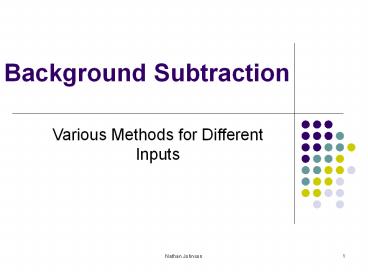Background Subtraction - PowerPoint PPT Presentation
Title:
Background Subtraction
Description:
Wallflower Method Pixel Level. Makes initial judgment whether a pixel is in the ... Images from Wallflower: Principles and Practice of Background Maintenance, ... – PowerPoint PPT presentation
Number of Views:1227
Avg rating:3.0/5.0
Title: Background Subtraction
1
Background Subtraction
- Various Methods for Different Inputs
2
Purpose of Background Subtraction
- Reduce problem set for further processing
- Only process part of picture that contains the
relevant information - Segment the image into foreground and background
- Add a virtual background
3
Encountered Problems
- Lighting
- Shadows
- Gradual/Sudden illumination changes
- Camouflage
- Moving objects
- Foreground aperture
- Foreground object becomes motionless
- Bootstrapping
4
Lighting and Shadows
- Weight the luminance with other characteristics
- Depth of object
- Region/Frame information
- Adjust the background model with time
- Store a history of previous backgrounds
5
Comparison of Two Techniques
- Wallflower
- Uses three different components
- Pixel, Region, and Frame levels
- Uses many different statistical models to
anticipate various changes in the background - Gordon, Darrell, Harville, Woodfill Subtraction
- Two or more cameras to measure distances
- Uses distance to determine foreground and falls
back on luminance
6
Wallflower Method Pixel Level
- Makes initial judgment whether a pixel is in the
foreground - Handles background model adaptation
- Addresses many of the classical problems
- Moved objects
- Time of day
- Camouflage
- Bootstrapping
7
Wallflower Region Frame
- Region level
- Refines the pixel level judgment
- Handles foreground aperture problem
- Frame level
- Sudden frame level change
- Uses previous models to figure out what caused
the sudden change - Light switching on/off
8
Results using Wallflower
9
Gordon, et al. Method
- Correctly identifies background depth and color
when it is represented in a minority of the
frames - Addition of range solves many of the classic
problems - Shadows
- Bootstrapping
- Foreground object becomes motionless
10
Obtaining Initial Background Model
- Records the (R,G,B,Z) values at each pixel
- Attempts to determine background through the
observed depth - Marks a pixel as invalid if there is not enough
information for the range - valid pixel range determines whether the pixel
is in the background, without the aid of the
(R,G,B) values - invalid pixel fall back on classic methods for
background subtraction
11
Gordon, et al. Method (cont.)
- rm is invalid
- ri is valid and smoothly connected to regions
with valid background data then a foreground
decision can be made - Solves the problem of the background being the
same depth as part of the foreground - Z-keying methods fail in these cases
- Kanade, Yoshida, Oda, Kano, and Tanaka, A
Video-Rate Stereo Machine and Its New
Applications, Computer Vision and Pattern
Recognition Conference, San Francisco, CA, 1996.
12
Gordon, et al. Method (cont.)
- YValid(Ym) Y gt Ymin
- Shadows have a stronger effect on luminance than
inter-reflections - Separate ratio limits for shadows and reflections
13
Problems Using Only Range or Color
14
Which is better?
- Wallflower over Gordon, et al.
- Doesnt require extra cameras to record depth
- Gordon, et al. produces a halo around
foreground objects - Gordon, et al. over Wallflower
- Handles more problems
- Tree waving
- Bootstrapping
15
Other Innovative Methods
- Fast, Lighting Independent Background Subtraction
- Advantages
- Light has no basis on the decision of foreground
- Disadvantages
- Requires a known, static background
- Multiple cameras
16
Which Method to Use
- Type of background present
- Static or Dynamic
- Lighting
- Gradual/Sudden changes
- Lack of lighting
- Hardware used during recording
- Multiple cameras
- Speed required for application
17
Conclusion
- Record as much information as possible
- Background subtraction methods have mainly been
looked at in particular situations - Severe case Fast, Lighting Independent Method
- A method to use in every case is still being
researched - Currently combinations of previously released
methods offer the best results for background
subtraction































